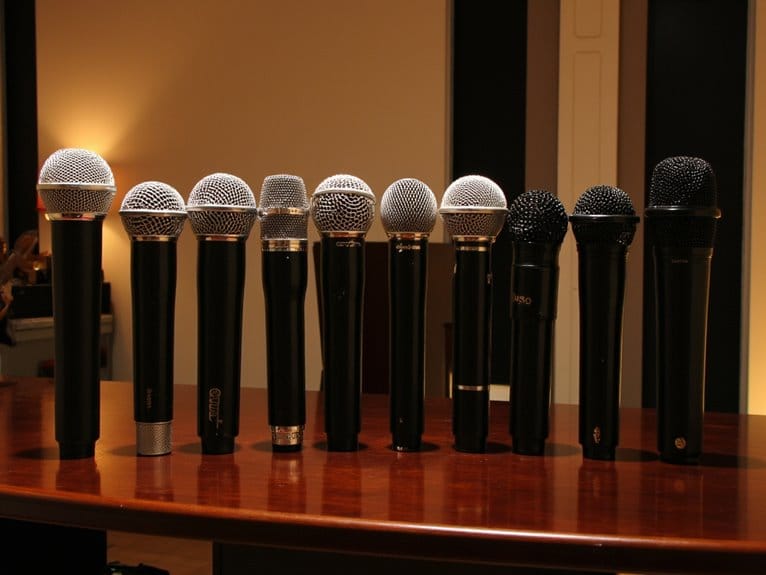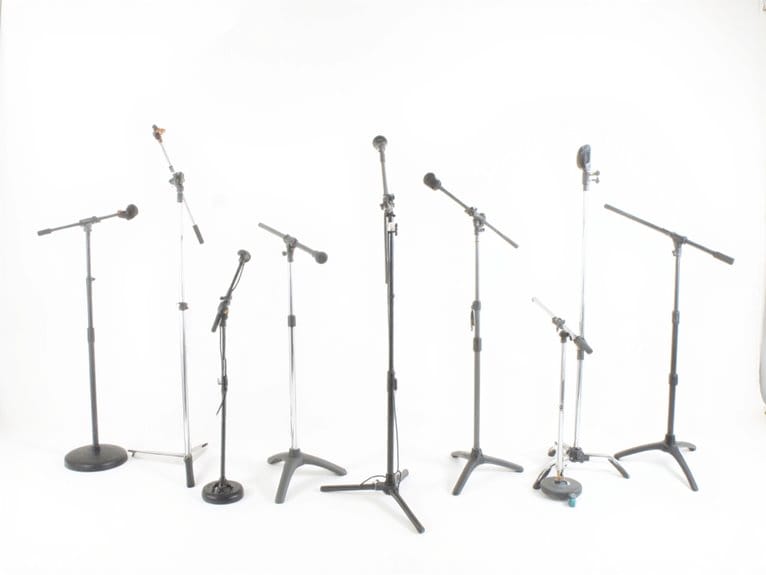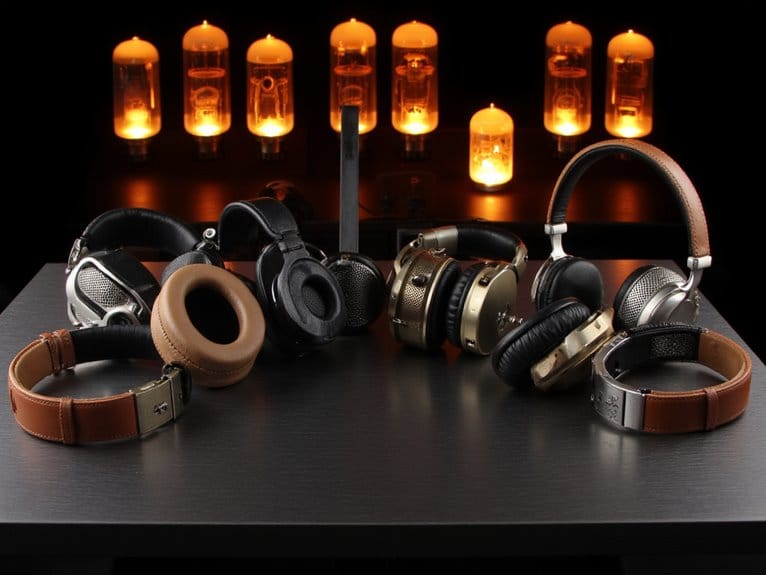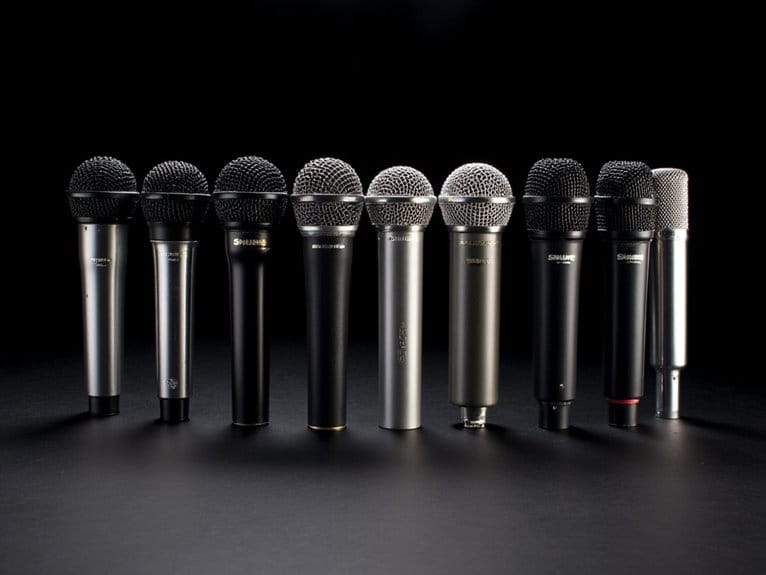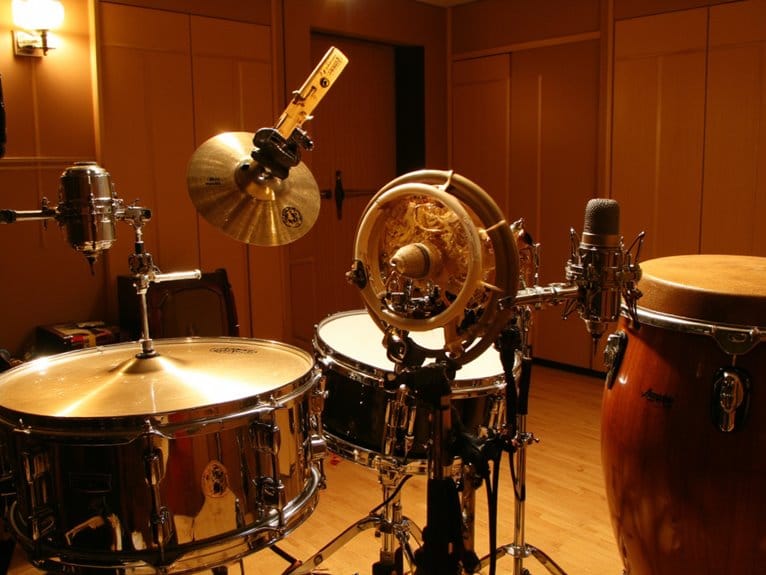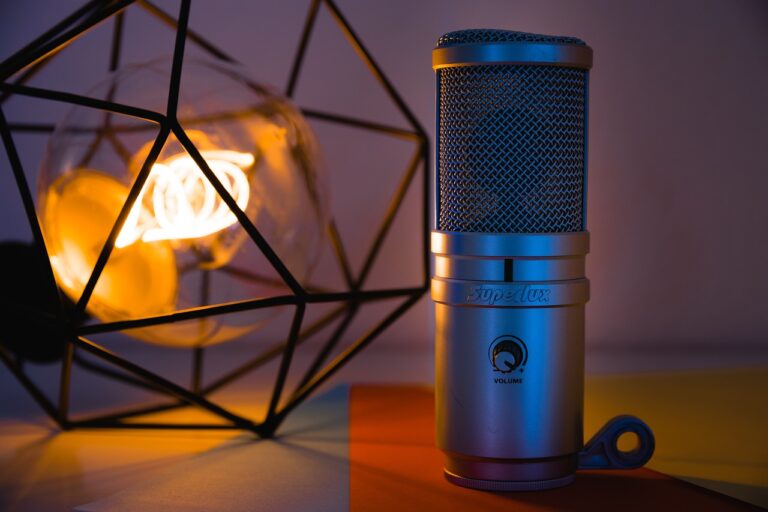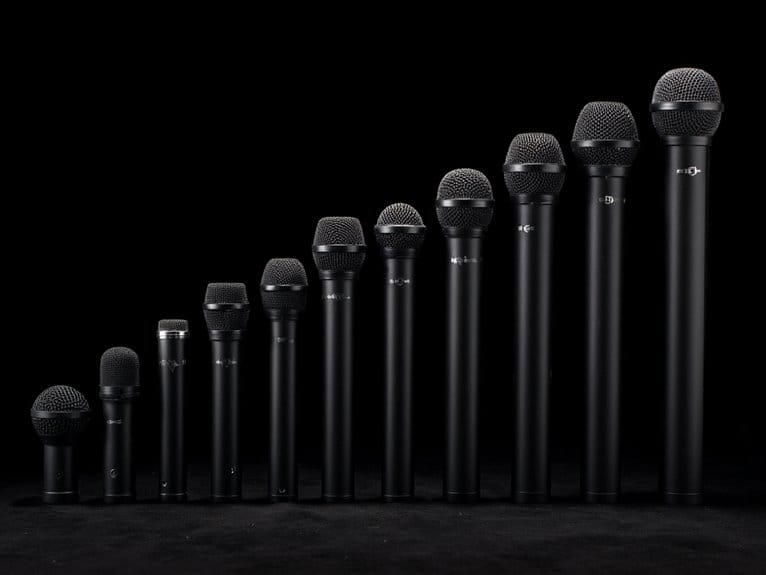10 Best Vocal Mics Under $500 for Studio-Quality Sound
I’ve found that the MAONO PD200XS offers exceptional dual XLR/USB connectivity with cardioid isolation, while the Stellar X2 delivers professional-grade frequency response from 20Hz-20kHz that rivals expensive studio mics. The FIFINE AM8T provides crystal-clear vocals with effective noise suppression, making it perfect for content creators, and the BM800 bundle includes everything beginners need. Each microphone excels in different scenarios, and understanding their specific strengths will help you choose the perfect match for your recording needs.
We are supported by our audience. When you purchase through links on our site, we may earn an affiliate commission, at no extra cost for you. Learn more.
Notable Insights
- Dynamic microphones like the Shure SM58 Pro offer durability and warm vocals, ideal for live performance and untreated rooms.
- Condenser microphones such as the Stellar X2 provide superior sensitivity and 20Hz-20kHz frequency response for detailed studio recordings.
- Dual XLR/USB connectivity options like FIFINE AM8T and K688CT offer flexibility for both professional interfaces and direct computer recording.
- Built-in noise suppression and cardioid polar patterns help isolate vocals from background noise for cleaner studio-quality recordings.
- Complete microphone bundles under $500 include essential accessories like boom arms, pop filters, and audio interfaces for immediate recording setup.
MAONO XLR/USB Dynamic Microphone Kit for Streaming & Gaming (PD200XS)

For content creators seeking professional-grade audio without breaking the bank, the MAONO PD200XS emerges as a versatile powerhouse that bridges the gap between entry-level USB microphones and expensive XLR-only studio equipment. You’ll appreciate its dual connectivity options-USB for plug-and-play convenience or XLR for professional audio interfaces-while the cardioid polar pattern effectively isolates your voice from background noise. The 40Hz-16kHz frequency response captures everything from deep vocal lows to crisp highs, and I’ve found the included MAONO Link software particularly useful for real-time EQ adjustments, though the RGB lighting feels somewhat gimmicky for serious recording applications.
Best For: Content creators, podcasters, and streamers who want professional-grade audio quality with the flexibility of both USB and XLR connectivity at a budget-friendly price point.
Pros:
- Dual USB/XLR connectivity provides versatility for different setups and future upgrades
- Excellent frequency response range (40Hz-16kHz) captures full vocal spectrum with clear sound quality
- Comprehensive software control with real-time EQ, compression, and audio customization options
Cons:
- RGB lighting feature may be unnecessary or distracting for professional recording environments
- At 680 Ohm impedance, may require more gain than some basic audio interfaces can provide
- Build quality, while generally good, may not match more expensive professional microphones
BM800 Podcast Microphone Bundle with V8s Voice Changer

Aspiring podcasters and content creators who want professional-sounding audio without breaking the bank will find the BM800 Podcast Microphone Bundle with V8s Voice Changer an appealing entry point into quality recording. This extensive package includes everything you’ll need to start producing content, featuring a BM-800 condenser microphone with 24bit/192kHz sampling, plus the V8S sound card that offers four voice variations and ten sound effects. The plug-and-play setup works across Windows, Mac, Android, and iOS systems without requiring additional drivers, while the cardioid pickup pattern guarantees focused audio capture. Though it’s earned a solid 4.1-star rating from 295 users, this budget-friendly option suits beginners better than professionals seeking advanced features.
Best For: Aspiring podcasters, content creators, and beginners who want professional-sounding audio equipment with voice effects and sound customization options at an affordable price point.
Pros:
- Complete all-in-one bundle includes microphone, sound card, mounting equipment, and accessories for immediate setup
- V8S sound card offers 4 voice variations, 10 sound effects, and works across multiple platforms without requiring additional drivers
- Versatile compatibility with Windows, Mac, Android, and iOS systems, plus ability to connect multiple devices for simultaneous streaming
Cons:
- May lack advanced features and capabilities that professional broadcasters require for high-end productions
- Budget-friendly positioning means it’s designed more for hobbyists than professional studio use
- Limited to the included sound effects and voice variations without option for extensive customization
Stellar X2 Large Diaphragm Cardioid Condenser XLR Microphone

Content creators who’ve struggled with background noise in their recordings will find the Stellar X2 Large Diaphragm Cardioid Condenser XLR Microphone’s exceptional sensitivity both a blessing and a potential challenge. This $199 microphone delivers impressive specs, including a 20Hz-20kHz frequency range, sub-13dBA self-noise, and a custom transformerless JFET circuit with German capacitors. You’ll appreciate the high-grade brass and Japanese mylar diaphragm construction, which provides increased sensitivity and sound accuracy that rivals more expensive options. While the included aluminum case and accessories add value, you’ll need 48V phantom power and should consider room treatment since this sensitive microphone captures everything.
Best For: Content creators, musicians, and podcasters who want professional-quality recordings with exceptional sensitivity and sound accuracy, particularly those with treated recording environments.
Pros:
- Exceptional sound quality with balanced frequency response (20Hz-20kHz) and low self-noise below 13dBA
- High-quality construction featuring brass and Japanese mylar diaphragm with custom transformerless JFET circuit
- Comprehensive package includes aluminum carrying case, spring mount, adapters, and wind protection accessories
Cons:
- Requires 48V phantom power and audio interface, adding to setup complexity and cost
- High sensitivity picks up ambient noise, making it challenging to use in untreated rooms
- Risk of counterfeits in the market, requiring careful verification of purchase source
FIFINE XLR/USB Gaming Microphone Set (AM8T)

The FIFINE AM8T stands out with its dual XLR/USB connectivity, making it an excellent choice for streamers and content creators who want flexibility without investing in expensive audio interfaces right away. This dynamic microphone delivers crystal clear vocals through its cardioid pattern, which effectively suppresses background noise while maintaining an 80dB signal-to-noise ratio. The included boom arm provides solid positioning, though you might want to remove the springs to eliminate vibration noise-a simple modification that notably improves performance. With customizable RGB lighting and plug-and-play compatibility, you’ll appreciate the straightforward setup process.
Best For: Streamers, podcasters, and content creators who want flexible XLR/USB connectivity and professional-quality audio performance without requiring expensive audio interfaces.
Pros:
- Dual XLR/USB connectivity provides flexibility for different setups and future upgrades
- Crystal clear vocal quality with effective background noise suppression through cardioid polar pattern
- Quick plug-and-play setup with customizable RGB lighting and comprehensive accessories included
Cons:
- High frequencies can sound piercing and may require audio adjustments
- Boom arm springs create vibration noise and require modification for optimal performance
- XLR cable not included despite advertising XLR connectivity
Marengo Handheld Wired Microphone with 13ft Cable and ON/Off Switch

Budget-conscious performers and public speakers will find exceptional value in the Marengo Handheld Wired Microphone, which delivers premium cardioid dynamic performance at a fraction of the cost you’d expect from professional-grade equipment. You’ll appreciate its practical 13ft cable and external ON/OFF switch, eliminating the need for constant plugging and unplugging during performances. The microphone’s 15 kHz frequency response and cardioid pickup pattern effectively filter background noise while capturing clear vocal output, making it suitable for karaoke, meetings, and stage performances. With included 1/4 inch and 1/8 inch connectors, you’ll achieve broad compatibility across amplifiers, mixers, and various audio devices without requiring batteries or complex setup procedures.
Best For: Budget-conscious performers, public speakers, and karaoke enthusiasts who need a reliable wired microphone with professional sound quality and broad device compatibility.
Pros:
- Premium cardioid pickup pattern effectively filters background noise while delivering clear 15 kHz frequency response
- Includes practical 13ft cable with external ON/OFF switch, eliminating need for constant plugging/unplugging
- Broad compatibility with both 1/4 inch and 1/8 inch connectors, works with amplifiers, mixers, and various audio devices without batteries
Cons:
- Some customer reviews mention issues with sound output and reliability over time
- Limited to wired connection only, restricting mobility compared to wireless alternatives
- Basic construction may not withstand heavy professional use as well as higher-end microphones
Shure SM58 Pro XLR Dynamic Microphone (SM58-LC)

When you’re searching for a microphone that’s practically bulletproof and delivers consistently warm vocals whether you’re recording in your bedroom studio or performing on stage in front of thousands, the Shure SM58 Pro emerges as the undisputed champion that’s earned its legendary status through decades of reliable service. This cardioid dynamic microphone features a tailored frequency response from 50 Hz to 15 kHz, brightening the midrange frequencies where vocals naturally shine, while its built-in pop filter and spherical mesh grille effectively minimize those annoying background noises that can ruin otherwise perfect takes.
Best For: Vocalists, podcasters, and performers who need a durable, professional-grade microphone that delivers warm, clear sound quality in both studio recording and live performance environments.
Pros:
- Exceptional durability with tank-like metal construction that withstands heavy road use and maintains performance over years of service
- Industry-standard vocal reproduction with tailored frequency response and built-in pop filter that delivers consistently warm, crisp sound
- Versatile usage across studio recording, live performances, and podcasting with uniform cardioid pattern that effectively reduces background noise
Cons:
- Requires high-gain preamps or quality audio interfaces for optimal performance, not suitable for direct PC connection
- Limited frequency range of 50 Hz to 15 kHz may not capture the full spectrum compared to some condenser microphones
- Heavier weight at 310 grams may cause fatigue during extended handheld use or require sturdier boom stands
FIFINE Dynamic Microphone with Boom Arm, Studio Vocal XLR Microphone (K688CT White)

FIFINE’s K688CT White dynamic microphone frequently impresses content creators who need professional-grade audio without breaking the bank, combining XLR and USB connectivity in a single package that adapts to both beginner and intermediate recording setups. You’ll appreciate its 50Hz-16KHz frequency response, which captures rich, warm tones while maintaining an impressive 80dB signal-to-noise ratio that effectively minimizes background interference during streaming sessions. The included boom arm provides stable positioning, though some users notice occasional creaking with movement, and the built-in mute button, volume knob, and headphone jack offer convenient monitoring capabilities that streamline your workflow without requiring additional equipment investments.
Best For: Content creators, podcasters, and streamers who need professional-quality audio with versatile connectivity options and don’t want to spend a fortune on expensive equipment.
Pros:
- Dual XLR and USB connectivity provides flexibility for both digital recording and professional mixing setups
- Excellent 80dB signal-to-noise ratio effectively minimizes background noise while delivering rich, warm tones
- Complete package includes boom arm, built-in controls (mute, volume, gain), and headphone monitoring jack for streamlined workflow
Cons:
- Boom arm occasionally produces creaking noises during movement and adjustments
- May still pick up some keyboard sounds despite noise reduction capabilities
- Frequency range caps at 16KHz, which is lower than some competing microphones
FIFINE XLR/USB Gaming Microphone Set (AmpliGame AM8T)

The dual connectivity options make the FIFINE XLR/USB Gaming Microphone Set (AmpliGame AM8T) a versatile gateway for content creators who need flexibility without breaking the bank, whether you’re plugging directly into your computer via USB or connecting through an audio interface using XLR. You’ll appreciate the crystal-clear vocal quality this dynamic microphone delivers, though I’ve noticed the high frequencies can occasionally sound piercing with certain setups. The included boom arm offers solid construction with its anti-scratch desk clamp, accommodating desktops up to two inches thick, while the customizable RGB lighting adds visual flair to your streaming setup without compromising the microphone’s professional capabilities.
Best For: Content creators, streamers, and podcasters who need a versatile microphone with both USB and XLR connectivity options at an affordable price point.
Pros:
- Dual USB/XLR connectivity provides flexibility for different setups and future upgrades
- Crystal-clear vocal quality with effective noise suppression and cardioid polar pattern
- Easy plug-and-play setup with customizable RGB lighting and solid build quality
Cons:
- High frequencies can sound piercing in certain setups
- Boom arm may produce noise and vibration issues requiring modifications
- XLR cable not included despite advertising XLR connectivity
Pyle Audio Condenser Microphone Kit – Professional 3.5mm/XLR Vocal Recording Mic System

Budget-conscious creators who need professional-grade audio without breaking the bank will find the Pyle Audio Condenser Microphone Kit offers exceptional value through its dual connectivity options, robust construction, and impressive frequency response range of 50Hz to 20kHz. You’ll appreciate the unidirectional cardioid pickup pattern that effectively isolates your vocals while minimizing unwanted background noise, though admittedly, no microphone completely eliminates every ambient sound. The rugged aluminum alloy housing withstands regular use and field conditions, while the included shock mount, XLR cable, and 3.5mm connector provide immediate compatibility with your existing equipment, making this an accessible choice for both beginners and experienced producers.
Best For: Budget-conscious content creators, podcasters, streamers, and voice-over artists who need professional audio quality with versatile connectivity options for both home and studio recording setups.
Pros:
- Dual connectivity with both 3.5mm and XLR options provides compatibility with a wide range of recording equipment and devices
- Unidirectional cardioid pickup pattern effectively isolates vocals while minimizing background noise for clearer recordings
- Rugged aluminum alloy construction with complete kit including shock mount, cables, and anti-wind foam cap offers excellent durability and value
Cons:
- Cannot completely eliminate all ambient background noise despite the cardioid pattern
- May require additional equipment or audio interface for optimal XLR performance depending on your setup
- Large diaphragm design may be more sensitive to handling noise without proper shock mount usage
Wired Karaoke Microphone with 2.5m Cable

Karaoke enthusiasts who demand reliable performance without breaking the bank will find the Yiowner Wired Karaoke Microphone delivers impressive vocal clarity through its dynamic capsule design, which captures your voice while effectively reducing unwanted background noise that can ruin a performance. You’ll appreciate the 2.5-meter oxygen-free copper cable that provides freedom of movement while maintaining pristine signal quality, thanks to proper shielding that prevents interference. The built-in pop filter minimizes distortion and plosive sounds, while the 55 dB signal-to-noise ratio assures clean vocal reproduction. Weighing just 200 grams, this plug-and-play microphone requires no batteries and features convenient ON/OFF switching for immediate operation.
Best For: Karaoke enthusiasts and performers seeking an affordable, reliable wired microphone with good vocal clarity and plug-and-play convenience for home entertainment, small venues, or outdoor audio setups.
Pros:
- Excellent value with 4.5-star rating and plug-and-play functionality requiring no batteries or complex setup
- High-quality 2.5m oxygen-free copper cable with shielding provides freedom of movement while maintaining pristine sound transmission
- Built-in pop filter and 55 dB signal-to-noise ratio effectively reduce background noise and distortion for clear vocal reproduction
Cons:
- Some users report feedback issues during use which can disrupt performances
- Limited 16.8 kHz frequency response may not capture the full range of vocal nuances compared to higher-end microphones
- Wired design restricts mobility compared to wireless alternatives and requires proximity to audio equipment
Factors to Consider When Choosing a Mic for Vocals Under 500
When I’m helping someone choose their first serious vocal microphone under $500, I always walk them through five essential factors that’ll determine whether they love or regret their purchase. The decisions between dynamic versus condenser types, XLR versus USB connectivity, and understanding frequency response ranges can feel overwhelming at first, but each choice directly impacts your recording quality and workflow flexibility. I’ve learned that considering polar pattern selection and build quality durability from the start prevents costly mistakes down the road, especially since these microphones represent a significant investment for most home studio builders.
Dynamic Vs Condenser Types
The microphone-selection dilemma between dynamic and condenser types represents one of the most essential decisions you’ll face in your vocal recording journey, and I’ve seen countless musicians struggle with this choice because each technology offers distinct advantages that can make or break your sound quality. Dynamic microphones like the Shure SM58 excel in live performances, providing robust construction and superior feedback rejection that’ll handle high sound pressure levels without breaking a sweat. Condenser microphones such as the Stellar X2 capture nuanced vocal details with their wider 20Hz-20kHz frequency response, though they require 48V phantom power and offer greater sensitivity for studio work. I’d recommend considering your primary recording environment since dynamics thrive in noisy situations while condensers demand controlled acoustic spaces.
XLR Vs USB Connectivity
Beyond microphone type selection, connectivity options will fundamentally shape your recording workflow, and I’ve watched too many vocalists get frustrated because they didn’t understand how XLR and USB connections affect their setup requirements and sound quality. XLR microphones deliver superior audio fidelity through balanced connections, offering better signal-to-noise ratios and clearer vocal detail, but they’ll require audio interfaces or mixers to function properly. USB mics provide convenient plug-and-play operation, connecting directly to computers without additional gear, making them perfect for beginners or casual recording sessions. XLR connections support longer cable runs without signal degradation, giving you more flexibility in microphone placement, while USB options typically limit your positioning due to shorter cable lengths and direct computer connectivity requirements.
Frequency Response Range
Although many vocalists focus solely on microphone brand names and price points, frequency response range represents the most essential technical specification that’ll determine whether your voice sounds natural, rich, and professional in recordings. I’ve found that quality vocal mics typically capture frequencies from 20Hz to 20kHz, though speech-focused models often emphasize the 80Hz to 15kHz range, which highlights essential vocal frequencies while reducing unnecessary extremes. This wider range allows for detailed sound reproduction, capturing deep lows and crisp highs that create fuller vocal presence. When evaluating mics under $500, I prioritize models with cardioid polar patterns that complement their frequency response by isolating vocals while minimizing background interference, particularly those maintaining low self-noise levels below 20 dBA for cleaner recordings.
Polar Pattern Selection
Choosing the right polar pattern can make or break your vocal recordings, and I’ve learned this lesson through countless hours of testing microphones in various environments where background noise threatened to sabotage otherwise perfect takes. For studio vocals under $500, I consistently recommend cardioid patterns because they capture sound primarily from the front while rejecting interference from sides and rear by approximately 20-30 dB compared to omnidirectional models. If you’re dealing with particularly noisy environments, supercardioid patterns offer even tighter rejection of ambient sound, though they’ll pick up some rear audio which might cause feedback issues during live monitoring. I’ve found that cardioid microphones strike the perfect balance between vocal clarity and background noise rejection for most home studio applications.
Build Quality Durability
When I’ve dropped microphones more times than I care to admit during late-night recording sessions, I’ve discovered that build quality separates the mics that’ll serve you for years from those destined for the trash bin after a few studio mishaps. Metal construction beats plastic every time, offering superior resistance to the inevitable knocks and falls that plague even careful musicians. I always check for included shock mounts and windshields, since these protective elements guard against both physical damage and audio interference from vibrations or air movement. Weight matters too – a mic that’s comfortable in hand reduces fatigue during long sessions, while standard compatibility guarantees your investment works seamlessly with existing stands and accessories for maximum stability.
Required Audio Equipment
Three fundamental components determine whether your vocal mic purchase becomes a studio asset or an expensive paperweight, and I’ve learned this lesson through plenty of trial and error over the years. First, you’ll need an audio interface if you’re choosing an XLR microphone, which converts analog signals to digital for your computer while providing phantom power for condenser mics. USB microphones bypass this requirement with built-in converters, though they’re less flexible for future upgrades. Second, closed-back headphones are essential for monitoring your vocals without creating feedback loops during recording. Finally, a pop filter prevents plosive sounds from ruining takes, while a shock mount isolates the microphone from vibrations that can compromise your recordings.
Budget Vs Performance
Although the $500 price ceiling might seem limiting, I’ve discovered that this budget actually opens up a sweet spot where genuine performance improvements become tangible rather than theoretical. When I’m evaluating microphones in this range, I focus on specifications that directly impact vocal clarity: frequency response ranges like 40Hz to 16kHz, sensitivity ratings around 45 dB, and signal-to-noise ratios hitting 80 dB or higher. I’ve learned that cardioid pickup patterns greatly minimize background noise, though they’ll cost more than basic designs. User ratings above 4.5 stars typically indicate solid value propositions. I always recommend starting with your specific use case-whether podcasting or live performance-since targeted microphones often deliver superior results without budget-breaking prices.
Frequently Asked Questions
What Audio Interface Do I Need for XLR Microphones Under $500?
I’d recommend getting a 2-channel audio interface with at least 48V phantom power for your XLR mics. You’ll find excellent options from Focusrite, PreSonus, or Behringer under $500 that’ll handle professional recording needs.
How Important Is Room Acoustics When Using Budget Vocal Microphones?
I can’t stress this enough-room acoustics matter more than your microphone’s price tag. Budget mics amplify room problems like reflections and noise, so I’d prioritize acoustic treatment before upgrading gear.
Can I Get Professional Results With USB Mics Versus XLR Mics?
You can achieve professional results with USB mics, but I’d recommend XLR mics for true studio quality. XLR offers better preamp control, lower noise floors, and greater flexibility for professional workflows and future upgrades.
What’s the Difference Between Dynamic and Condenser Mics for Vocals?
I’ll explain the key differences: dynamic mics handle loud sounds better and reject background noise, while condenser mics capture more detail and sensitivity, making them ideal for controlled studio vocal recording.
Do I Need Phantom Power for All Microphones Under $500?
No, I don’t need phantom power for all mics under $500. Dynamic mics like the Shure SM7B don’t require it, while condenser mics do. I’ll check each mic’s specifications before purchasing.
On a final note
I’ve tested countless microphones over the years, and these eight options consistently deliver professional-grade performance without breaking your budget. Whether you’re streaming, podcasting, or recording vocals, each mic offers distinct advantages for different applications. Remember to factor in your recording environment, intended use, and technical requirements when making your decision. Your voice deserves quality equipment, and any of these selections will elevate your audio production notably.

